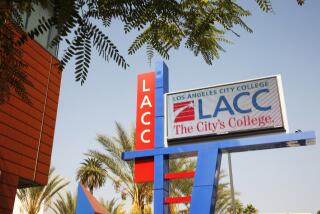Measuring Effectiveness of Community Colleges
- Share via
The article on community colleges (Oct. 20) contains an amazing quote from J. Gary Shansby, chairman of the Commission for the Review of the Master Plan for Higher Education. Shansby, a chief executive officer of Shaklee Corp., may have qualified his statement in some way that was not included in the article, but all we read was something that raised questions about Shansby’s understanding of the problem.
Shansby stated, “We need a better way to govern the community colleges. The system just isn’t as effective as UC or Cal State.” I may agree that we need a better way to govern the community colleges, but I can’t imagine what he means by the system not being as effective as UC or Cal State. How does he measure effectiveness?
If Shansby measures effectiveness by the number of students a system educates, the community college system is the most effective. In 1982-83, the UC system had 129,643 students, the Cal State system had 241,407 students, while the California community college system educated 650,696 students.
If Shansby measures effectiveness by the cost of educating a student, the community college system is the most effective. In 1982-83 the UC system cost per student was $8,681, the Cal State system cost was $3,759, while the state community college system cost per student was $2,052. Clearly, by using cost-effectiveness techniques used by corporations, the community colleges are the most effective.
If Shansby measures effectiveness by the difficulty an institution faces in educating its students, the community college system is the most effective. The UC system educates the top 12 1/2% of the high school graduating class; the Cal State system educates those graduates down to 33% of the graduating classes; the community colleges educate all the rest. They educate those over 18 whether they have even attended high school; those who attended and did not succeed in high school; those from other parts of our country or the world where education is less adequate; those who have been out of school from 10 to 30 years or more; those with serious physical handicaps; and those who are seriously handicapped by severe economic deprivation.
If Shansby measures effectiveness by the ability of a system to continue functioning despite a lack of adequate financial support from the state, the community colleges have set an amazing record in recent years.
This has been, especially, a problem under Gov. George Deukmejian. The governor has permitted adequate financing of the UC and Cal State systems--at least after his first year in office--while striking a series of catastrophic and economic blows to the community colleges. Still, the colleges have continued to function and serve their students’ needs.
HAROLD W. GARVIN
Los Angeles
Garvin is vice president of the board of trustees of the Los Angeles Community Colleges.
More to Read
Sign up for Essential California
The most important California stories and recommendations in your inbox every morning.
You may occasionally receive promotional content from the Los Angeles Times.













